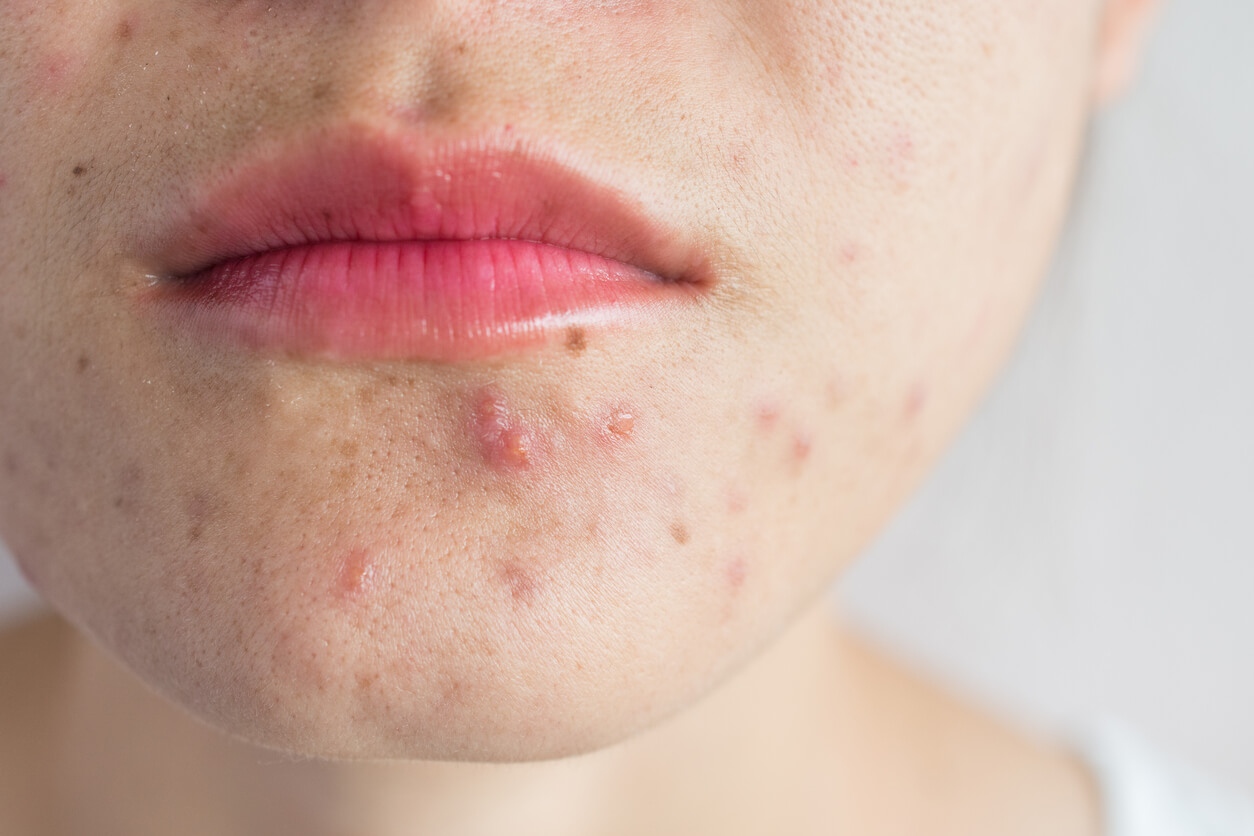Children Ages 12 to 14: Changes and Evolution

We all have basic notions about what adolescence is and the changes it entails; however, it’s a long stage that doesn’t always occur in the same way. Children between the ages of 12 and 14 go through early adolescence, which is a period of enormous changes and transformations.
This stage begins with puberty or the period of sexual maturation. Therefore, minors find themselves in limbo between childhood and youth. This makes it difficult for them to find their place and deal with their physical and mental evolution in the best way.
It’s also not easy for parents to accompany this process with their children and that’s why today, we’re going to offer you some relevant data and advice about it. Keep reading!
The main changes in children ages 12 to 14
The evolution that occurs during adolescence happens on multiple levels, but they don’t always coincide in time. Therefore, it’s possible to see a child with a mature body that still displays childish behavior. Or, on the contrary, children that are very mature mentally who have a physical development that’s delayed compared to that of their peers.
In any case, these are the main changes that boys and girls face at this stage. Take note!
On a physical level
The physical changes that come from sexual maturation are the most evident. In both boys and girls, the so-called pubertal growth spurt takes place. This involves growth in height and weight, which accompanies the development of the following secondary sexual characteristics:
- In girls, the mammary bud appears and the size of the breasts and hips increases. Subsequently, the first menstruation appears.
- In boys, the size of the scrotum and testicles increases, muscle mass and strength increase, and nocturnal emissions appear.
On the other hand, in both sexes, the growth of body hair is seen, especially on the legs, in the armpits, and on the pubis. In the case of males, it can also appear on the chest and face. In addition, the skin becomes oilier and juvenile acne may appear.
All these changes are mediated by hormonal processes, led by growth hormone, androgens (in boys), and estrogens and progesterone (in girls).

On a cognitive level
Children ages 12 to 14 are already in the last stage of cognitive development proposed by Jean Piaget: That of formal operations.
By this time, they’re already able to make use of logic and abstraction, carry out complex reasoning, and establish moral philosophies. Also, they can outline critical thinking that leads them to question what’s established and to create a scale of values of their own.
However, these skills are still developing and won’t be fully mastered by children until late adolescence.
Finally, it’s important to note that during early adolescence, the brain also continues to develop. In particular, certain regions, such as the prefrontal cortex, haven’t finished maturing, which translates into impulsivity and a tendency to take risks.
On an emotional level
If your child’s in early adolescence, you’ll probably agree that this is one of the most notorious changes of this stage.
At this age, events are experienced with unusual intensity. There’s a great emotional lability that can lead them from euphoria to sadness for no apparent reason, and it’s common for feelings of incomprehension to appear.
Those closest to the child may also notice that the young person is often irritable and tends to isolate themselves on some occasions. These emotional reactions are linked to age-related hormonal changes and can be difficult to understand, even for the child themself.
On a social level
As is well known, during early adolescence, the peer group becomes a refuge and a point of reference. Children between 12 and 14 years of age increasingly demand more independence and seek a relative detachment from their family in order to connect with their peers.
They’ll try to fit into the social group, share codes and rituals, and, in short, belong. Sometimes this can cause some stress and suffering and also lead them to make bad decisions if emotions aren’t managed properly.
Some tips for parents of children ages 12 to 14
As parents, we have to go through these processes with our children and it’s normal that sometimes we don’t know how to act. Therefore, it’s worth taking into account the following recommendations to better accompany them.
Take care of their lifestyle habits
The lifestyle of each person begins to develop in childhood, but consolidates in adolescence.
Nowadays, we can no longer completely control what they eat, how much they sleep, or what our children do during the day. Therefore, it’s essential that they understand the value of good habits and that they decide to implement them out of their own desire and not out of obedience.
It’s especially necessary to take care of the amount of sleep they get, as adolescents tend to stay up late and this can lead to significant deprivation.
In addition, food and physical exercise should be seen as forms of self-care and ways to materialize self-love. Not as a means to fit into the ideal of beauty established by the environment, as this could lead to eating disorders.

Accept their growth
For many parents, it’s complicated to see how, from one day to the next, their 12 to 14-year-old children have transformed and are now young, surly, and independent. It’s important not to take their behavior personally and to do your own inner work to be able to accompany them with love and respect.
You also need to progressively offer the autonomy that children demand, as they’re in an evolutionary moment of building their identity and consolidating bonds with their peers.
Don’t forget to set limits
Finally, don’t forget that adolescents still need limits. As much as they may resist them, they provide kids with the guidance, security, and consistency required to fly away from the nest.
Obviously, these limits will have to be flexible and adapted to the age and maturity of the young person, but they must be present at all times. Respect, responsibility, and sincerity can be the maxims that are requested from the adolescent at home.
Final recommendations
In short, children ages 12 to 14 are going through one of the most complicated stages of human development. As such, parents and children need to be aware of what’s happening and come to understand it.
Talking with children about physical and emotional changes, what to expect, and the best ways to manage these transformations is an important task. Such conversations may be uncomfortable at first, but it’s key not to postpone or avoid them.
Providing children with good tools at the right time will make all the difference in their lives.
We all have basic notions about what adolescence is and the changes it entails; however, it’s a long stage that doesn’t always occur in the same way. Children between the ages of 12 and 14 go through early adolescence, which is a period of enormous changes and transformations.
This stage begins with puberty or the period of sexual maturation. Therefore, minors find themselves in limbo between childhood and youth. This makes it difficult for them to find their place and deal with their physical and mental evolution in the best way.
It’s also not easy for parents to accompany this process with their children and that’s why today, we’re going to offer you some relevant data and advice about it. Keep reading!
The main changes in children ages 12 to 14
The evolution that occurs during adolescence happens on multiple levels, but they don’t always coincide in time. Therefore, it’s possible to see a child with a mature body that still displays childish behavior. Or, on the contrary, children that are very mature mentally who have a physical development that’s delayed compared to that of their peers.
In any case, these are the main changes that boys and girls face at this stage. Take note!
On a physical level
The physical changes that come from sexual maturation are the most evident. In both boys and girls, the so-called pubertal growth spurt takes place. This involves growth in height and weight, which accompanies the development of the following secondary sexual characteristics:
- In girls, the mammary bud appears and the size of the breasts and hips increases. Subsequently, the first menstruation appears.
- In boys, the size of the scrotum and testicles increases, muscle mass and strength increase, and nocturnal emissions appear.
On the other hand, in both sexes, the growth of body hair is seen, especially on the legs, in the armpits, and on the pubis. In the case of males, it can also appear on the chest and face. In addition, the skin becomes oilier and juvenile acne may appear.
All these changes are mediated by hormonal processes, led by growth hormone, androgens (in boys), and estrogens and progesterone (in girls).

On a cognitive level
Children ages 12 to 14 are already in the last stage of cognitive development proposed by Jean Piaget: That of formal operations.
By this time, they’re already able to make use of logic and abstraction, carry out complex reasoning, and establish moral philosophies. Also, they can outline critical thinking that leads them to question what’s established and to create a scale of values of their own.
However, these skills are still developing and won’t be fully mastered by children until late adolescence.
Finally, it’s important to note that during early adolescence, the brain also continues to develop. In particular, certain regions, such as the prefrontal cortex, haven’t finished maturing, which translates into impulsivity and a tendency to take risks.
On an emotional level
If your child’s in early adolescence, you’ll probably agree that this is one of the most notorious changes of this stage.
At this age, events are experienced with unusual intensity. There’s a great emotional lability that can lead them from euphoria to sadness for no apparent reason, and it’s common for feelings of incomprehension to appear.
Those closest to the child may also notice that the young person is often irritable and tends to isolate themselves on some occasions. These emotional reactions are linked to age-related hormonal changes and can be difficult to understand, even for the child themself.
On a social level
As is well known, during early adolescence, the peer group becomes a refuge and a point of reference. Children between 12 and 14 years of age increasingly demand more independence and seek a relative detachment from their family in order to connect with their peers.
They’ll try to fit into the social group, share codes and rituals, and, in short, belong. Sometimes this can cause some stress and suffering and also lead them to make bad decisions if emotions aren’t managed properly.
Some tips for parents of children ages 12 to 14
As parents, we have to go through these processes with our children and it’s normal that sometimes we don’t know how to act. Therefore, it’s worth taking into account the following recommendations to better accompany them.
Take care of their lifestyle habits
The lifestyle of each person begins to develop in childhood, but consolidates in adolescence.
Nowadays, we can no longer completely control what they eat, how much they sleep, or what our children do during the day. Therefore, it’s essential that they understand the value of good habits and that they decide to implement them out of their own desire and not out of obedience.
It’s especially necessary to take care of the amount of sleep they get, as adolescents tend to stay up late and this can lead to significant deprivation.
In addition, food and physical exercise should be seen as forms of self-care and ways to materialize self-love. Not as a means to fit into the ideal of beauty established by the environment, as this could lead to eating disorders.

Accept their growth
For many parents, it’s complicated to see how, from one day to the next, their 12 to 14-year-old children have transformed and are now young, surly, and independent. It’s important not to take their behavior personally and to do your own inner work to be able to accompany them with love and respect.
You also need to progressively offer the autonomy that children demand, as they’re in an evolutionary moment of building their identity and consolidating bonds with their peers.
Don’t forget to set limits
Finally, don’t forget that adolescents still need limits. As much as they may resist them, they provide kids with the guidance, security, and consistency required to fly away from the nest.
Obviously, these limits will have to be flexible and adapted to the age and maturity of the young person, but they must be present at all times. Respect, responsibility, and sincerity can be the maxims that are requested from the adolescent at home.
Final recommendations
In short, children ages 12 to 14 are going through one of the most complicated stages of human development. As such, parents and children need to be aware of what’s happening and come to understand it.
Talking with children about physical and emotional changes, what to expect, and the best ways to manage these transformations is an important task. Such conversations may be uncomfortable at first, but it’s key not to postpone or avoid them.
Providing children with good tools at the right time will make all the difference in their lives.
All cited sources were thoroughly reviewed by our team to ensure their quality, reliability, currency, and validity. The bibliography of this article was considered reliable and of academic or scientific accuracy.
- Águila Calero, G., Díaz Quiñones, J., & Díaz Martínez, P. (2017). Adolescencia temprana y parentalidad. Fundamentos teóricos y metodológicos acerca de esta etapa y su manejo. MediSur, 15(5), 694-700.
- Picó, A. M. (1991). Factores que controlan el aumento de crecimiento durante el estirón puberal (Doctoral dissertation, Universitat d’Alacant-Universidad de Alicante).
- Triskier, F. J. (2006). Algunas especulaciones respecto a las modificaciones neurobiológicas durante la adolescencia. VERTEX, Revista Argentina de Psiquiatría, 17(70), 424. http://www.editorialpolemos.com.ar/docs/vertex/vertex70.pdf#page=25
This text is provided for informational purposes only and does not replace consultation with a professional. If in doubt, consult your specialist.








